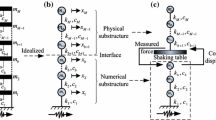Abstract
Hybrid simulation is a powerful test method for evaluating the seismic performance of structural systems. This method makes it feasible that only critical components of a structure be experimentally tested. This paper presents a newly proposed integration algorithm for seismic hybrid simulation which is aimed to extend its capabilities to a wide range of systems where existing methods encounter some limitations. In the proposed method, which is termed the variable time step (VTS) integration method, an implicit scheme is employed for hybrid simulation by eliminating the iterative phase on experimental element, the phase which is necessary in regular implicit applications. In order to study the effectiveness of the VTS method, a series of numerical investigations are conducted which show the successfulness of the VTS method in obtaining accurate, stable and converged responses. Then, in a comparative approach, the improved accuracy of the VTS method over commonly used integration methods is demonstrated. The stability of the VTS method is also studied and the results show that it provides conditional stability; however, its stability limit is well beyond the accuracy limit. The effect of time delay on the VTS method results is also investigated and it is shown that the VTS method is quite successful in handling this experimental error.
Similar content being viewed by others
References
Ahmadizadeh M and Mosqueda G (2008), “Hybrid Simulation with Improved Operator-splitting Integration Using Experimental Tangent Stiffness Matrix Estimation,” Journal of Structural Engineering, 134(12): 1829–1838.
Ahmadizadeh M, Mosqueda G and Reinhorn AM (2008), “Compensation of Actuator Delay and Dynamics for Real-time Hybrid Structural Simulation,” Earthquake Engineering and Structural Dynamics, 37(1): 21–42.
Carrion JE and Spencer BF (2006), “Real-time Hybrid Testing Using Model-based Delay Compensation,” 4th International Conference on Earthquake Engineering, Taipei, Taiwan.
Chang SY (2007), “Enhanced, Unconditional Stable, Explicit Pseudodynamic Algorithm,” Journal of Engineering Mechanics, 133(5): 541–554.
Chang SY (2010), “Explicit Pseudodynamic Algorithm with Improved Stability Properties,” Journal of Engineering Mechanics, 136(5): 599–612.
Chang SY (2013), “An Explicit Structure-dependent Algorithm for Pseudodynamic Testing,” Engineering Structures, 46: 511–525.
Darby AP, Williams MS and Blakeborough A (2002), “Stability Delay Compensation for Realtime Substructure Testing,” Journal of Engineering Mechanics, 128(12): 1276–1284.
Horiuchi T and Konno T (2001), “A New Method for Compensating Actuator Delay in Real-time Hybrid Experiments,” Philosophical Transactions of the Royal Society of London Series A-Mathematical Physical and Engineering Sciences, 359: 1786–1893.
Hung CC and El-Tawil S (2009a), “A Method for Estimating Specimen Tangent Stiffness for Hybrid Simulation,” Earthquake Engineering and Structural Dynamics, 38: 115–134.
Hung CC and El-Tawil S (2009b), “Full Operator Algorithm for Hybrid Simulation,” Earthquake Engineering and Structural Dynamics, 38: 1545–1561.
Mahin SA and Shing PSB (1985), “Pseudodynamic Method for Seismic Testing,” Journal of Structural Engineering, 111(7): 1482–1503.
Mosqueda G (2003), “Continuous Hybrid Simulation with Geographically Distributed Substructures,” PhD Dissertation, Civil and Environmental Engineering in the Graduate Division of the University of California, Berkeley.
Mosqueda G and Ahmadizadeh M (2007), “Combined Implicit or Explicit Integration Steps for Hybrid Simulation,” Earthquake Engineering and Structural Dynamics, 36: 2325–2343.
Mosqueda G and Ahmadizadeh M (2011), “Iterative Implicit Integration Procedure for Hybrid Simulation of Large Nonlinear Structures,” Earthquake Engineering and Structural Dynamics, 40: 945–960.
Mosqueda G, Stojadinovic B and Mahin SA (2007), “Real-time Error Monitoring for Hybrid Simulation. II: Structural Response Modification with Error,” Journal of Structural Engineering, 133(8): 1109–1117.
Nakashima M, Kaminoso T, Ishida M and Kazuhiro A (1990), “Integration Techniques for Substructure Online Test,” 4th US National Conference of Earthquake Engineering, Palm Springs, CA, 515–524.
Nakashima M and Masaoka N (1999), “Real-time Online Test for MDOF Systems,” Earthquake Engineering and Structural Dynamics, 28(4): 393–420.
Newmark NM (1959), “A Method of Computation for Structural Dynamics,” Journal of Engineering Mechanics, 85: 67–94.
Shing PSB, Nakashima M and Bursi O (1996), “Application of Pseudodynamic Test Method to Structural Research,” Earthquake spectra, 12: 29–56.
Author information
Authors and Affiliations
Corresponding author
Rights and permissions
About this article
Cite this article
Zakersalehi, M., Tasnimi, A.A. & Ahmadizadeh, M. A new integration scheme for application to seismic hybrid simulation. Earthq. Eng. Eng. Vib. 16, 69–81 (2017). https://doi.org/10.1007/s11803-017-0369-x
Received:
Accepted:
Published:
Issue Date:
DOI: https://doi.org/10.1007/s11803-017-0369-x



